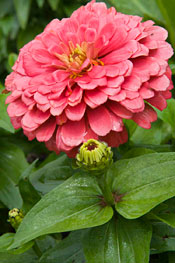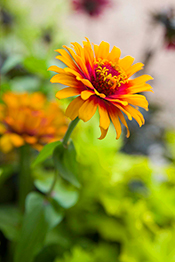Botanical Interests Seed Zinnia Cut and Come Again 1 Count
Zinnias: The Hardest-Working Bloom in the Summer Garden
In summertime, gardening requires plants with three central qualities: low maintenance (it'southward hot out in that location), heat and drought tolerance (ditto), and brilliant colour—the brighter the ameliorate.
Zinnias fit the beak on all three counts. And more. In fact, they're one of the all-time flowers that smart gardeners can put to work in their gardens.
Zinnias piece of work fast.
If in that location'due south an easier flower to grow, we'd like to know nearly it. Zinnias are annuals, meaning that they go from seed to flower to seed quickly. Zinnias' pointy seeds, shaped similar piffling arrowheads, require simply bones garden prep to sprout: sow them in well-tuckered soil, where at that place's full sun and lots of summer heat, and you'll have tiny seedlings in days, with flowers powering upwardly in just a few weeks. No perennial can merits that speed!
1 gardening friend doesn't even carp to prepare her soil—she simply sprinkles seeds wherever she'd similar a few zinnias, waters those spots for a couple of days, and lets zinnias' piece of cake-to-abound nature take its course.
Zinnias work wherever you demand colour.

'Pop Fine art'. 'Green Envy'. 'Persian Carpet'. 'Candy Cane'. With multifariousness names similar that, y'all know you're in for colour. Zinnias come in a preposterous palette of every vivid and pastel (except the blues), plus bi-colors, tri-colors, and crazy-quilt mixes designed for cutting, to attract pollinators, etc.
Bated from fresh color, many new zinnia series offering top and width options, too.
- While the tall versions of Zinnia elegans remain the archetype choice for the back of the border, shorter series now challenge the low ground once ceded to marigolds and petunias. The Magellan Series stay close to knee high at 14 inches, while the Thumbelina Serial of dwarf zinnias pinnacle at half-dozen to 8 inches.
- Creeping or spreading Zinnia angustifolia, such every bit the Crystal Series, are a revelation for the front of the edge, raised beds, containers, and even ground covers. This Mexican native is the get-to species for hot spots similar sidewalk beds or that no-man's-land beside the garage, since it's even more drought tolerant than mutual zinnias.
- Zahara™ zinnias top out at just 8 to 12 inches—and are prized for their resistance to powdery mildew and leaf spot (meet beneath). Zahara Xanthous is curt but sweet—we paired it with petite sunflowers in the entry beds at the Regenstein Fruit & Vegetable Garden.

Zinnias work as cut flowers.
Zinnias have style, in add-on to long, potent stems, and so they are naturally destined for the vase.
Wonderful language gets used when describing zinnia flowers: stars and daisies, dahlias and spiders, buttons and domes, and quill-foliage cactus. Flowers can be "singles," with petals lined upward in a row around an open up center, or semi-doubles, or doubles. All work marvelously in floral arrangements.
Of course, the tall varieties are the zinnias of choice for cut: 'Benary'southward Giant' is famous for its three-pes-alpine, sturdy stems and large flowers. Cut zinnia stems at an angle just above a bud joint. Zinnias are typically long-lasting in a vase—strip the stems of all but the nearly visible leaves before setting them in water.
Zinnias cutting your workload.
Zinnias are low maintenance. Since they're fast-growing, they shade out weeds. They don't require much in the way of fertilizing (but an occasional well-counterbalanced mix), and they don't need mulching.
Deadheading helps to produce more than flowers. No time to deadhead? The Zaharas mentioned in the sidebard are self-cleaning—a real time saver when information technology comes to a large bed.
Like Zaharas, the Profusion Series (hybrids betwixt Z. elegans and Z. angustifolia) are resistant to the scourge of zinnias: powdery mildew.
Because zinnias are native to the grasslands of the southwestern states, United mexican states, and South America, they know how to handle dry conditions. Simply wet summers (we've had ane and so far) can take their toll. And that tin can lead to powdery mildew and leaf spot. Three suggestions for dealing with wet conditions:
- Water only when needed, and so simply at the base of the plants. Wet leaves tin can promote mildew evolution, and splashing water can transfer fungus from the ground onto zinnia leaves in an instant.
- Cover-up tall, more mildew-decumbent varieties with other plants in the foreground.
- Do both #1 and #2 and alive with the fact that zinnia leaves (but not flowers) are affected by wet weather—as one horticulturist put it, "Even when zinnias are covered in powdery mildew, they're covered in flowers."
Zinnias work year after year.
Information technology'due south piece of cake to relieve zinnia seeds. Simply let the flowers dry fully on the stem, then collect the seedheads and lightly vanquish them in your mitt to release next year'due south seed crop. Store in a cool, dry place as you lot practise other seeds. (And set some aside in a labeled envelope for our Seed Swap next February!)
1 concluding reason to plant zinnias year later year: they're butterfly magnets. The bigger-flowered varieties act like landing pads for nectar-seeking butterflies. (Same goes for hummingbirds.) Endeavour alpine zinnias with red or hot pink flowers to go the biggest describe.
Karen Zaworski is a garden writer and photographer who lives and gardens in Oak Park, Illinois.
Source: https://www.chicagobotanic.org/plantinfo/zinnias_hardest_working_flower_summer_garden